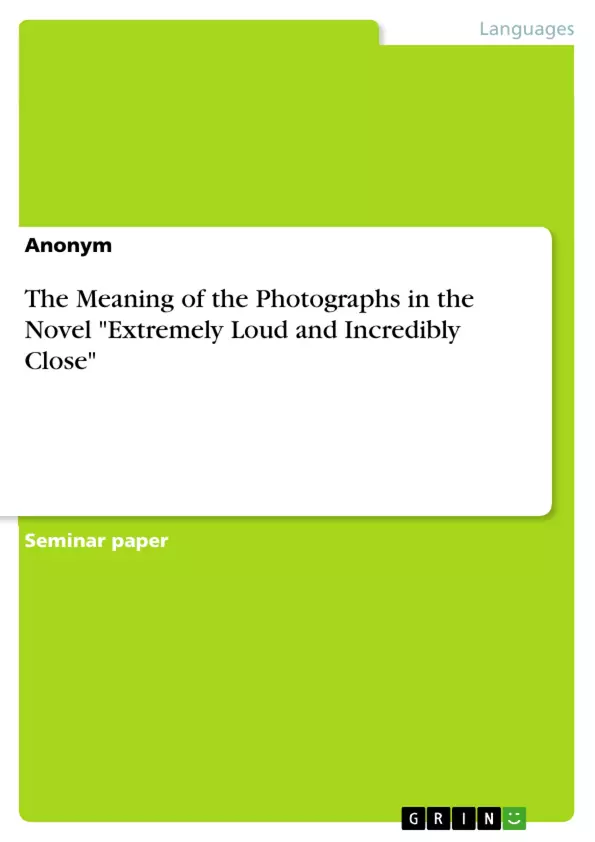In Jonathan Safran Foer's novel "Extremely Loud and Incredibly Close" photographs help the main character, Oskar Schell, to document his thoughts and feelings. Oskar is an intelligent and curious boy, so the photographs he collects in a scrapbook named "Stuff That Happened to Me" are rich in diversity.
First there are many pictures which refer directly or indirectly to family members, like his father and his grandfather. Moreover, Oskar collects pictures of people he is not related to but admires a lot, like Stephen Hawking or his cat. The third group of his photographs includes strangers whom the boy briefly or never met at all. Although not every photograph in the novel can be divided into these three groups, I will only focus on selected photographs according to the three groups.
This report will argue that every single group has its own function and reveals different things about Oskar. While photographs connected to his father or grandfather give away something about Oskar’s past and his way he of dealing with his loss, the second group, pictures about admired ones helps to become a better image of Oskar’s personality and his emotions. The third group that contains photographs of strangers represents his social interaction with foreigners and his interests.
Through analyzing some particular photographs in their contexts, I will achieve a deeper look into Oskar’s inside, so that I will gain more information about this character than the written pages in Foer’s novel offers. Moreover, I want to prove that most of the chosen photographs which appear in the protagonist’s scrapbook, whether they are taken by himself or by others, are connected to Thomas Schell Jr. and underline Oskar's emotional instability after his father’s death.
Table of Contents
- Title Page
- Executive Summary
- Preface
- Table of Contents
- 1. Introduction
- 2. Topic Description
- 3. Photographs of Characters Oskar Misses
- 3.1 Oskar's Father
- 3.2 Oskar's Grandfather
- 4. Photographs of Characters Oskar Admires
- 4.1 Stephen Hawking
- 4.2 Oskar's Cat
- 5. Photographs of Characters Oskar Superficially Knows
- 5.1 Abby Black
- 5.2 Two Cavemen and an Astronaut
- 6. Conclusion
- 7. Critical Appraisal
Objectives and Key Themes
This report explores the significance of the photographs in Jonathan Safran Foer's novel, "Extremely Loud and Incredibly Close". The main objective is to analyze the photographs featured in Oskar Schell's scrapbook, revealing insights into his character, his emotional journey, and the impact of his father's death. This analysis aims to demonstrate how these photographs contribute to the novel's narrative, showcasing Oskar's emotional instability, his attempts to cope with grief, and his talent as a photographer.
- The role of photography in navigating grief and loss
- The impact of the 9/11 attacks on Oskar's emotional state
- Oskar's character development and his artistic expression through photography
- The relationship between Oskar and his father, as depicted through photographs
- The exploration of themes of memory, identity, and the search for meaning
Chapter Summaries
The report begins by introducing the novel and its context, setting the stage for the analysis of the photographs. It then delves into the photographs of characters Oskar misses, particularly those related to his deceased father and grandfather, exploring how these images reflect his grief and longing. The analysis continues with photographs of characters Oskar admires, such as Stephen Hawking, showcasing his admiration for intellect and achievement, and his own attempts to understand the complexities of the world. The report concludes with a discussion of photographs of characters Oskar superficially knows, highlighting his curiosity and desire for connection, even in the midst of his emotional turmoil.
Keywords
This analysis focuses on the role of photography in navigating grief and loss, particularly in the context of Oskar Schell's experience after the 9/11 attacks. Key themes include emotional instability, character development, artistic expression, memory, identity, and the search for meaning. The report explores how these themes manifest in Oskar's scrapbook of photographs, revealing insights into his inner world and his coping mechanisms. The analysis draws upon the works of Susan Sontag and Jim Richardson, utilizing their perspectives on photography to enrich the understanding of the photographs in Foer's novel.
- Citar trabajo
- Anonym (Autor), 2018, The Meaning of the Photographs in the Novel "Extremely Loud and Incredibly Close", Múnich, GRIN Verlag, https://www.grin.com/document/465689



